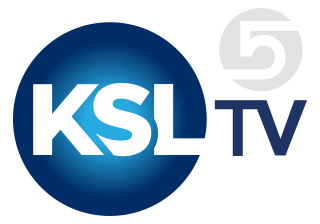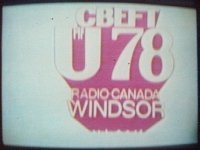Related Research Articles

KSL-TV is a television station in Salt Lake City, Utah, United States, affiliated with NBC. It is the flagship television property of locally based Bonneville International, the for-profit broadcasting arm of the Church of Jesus Christ of Latter-day Saints, and is sister to KSL radio. The three stations share studios at the Broadcast House building in Salt Lake City's Triad Center; KSL-TV's transmitter is located on Farnsworth Peak in the Oquirrh Mountains, southwest of Salt Lake City. The station has a large network of broadcast translators that extend its over-the-air coverage throughout Utah, as well as portions of Arizona, Idaho, Nevada and Wyoming.

WPTZ is a television station licensed to Plattsburgh, New York, United States, serving as the NBC affiliate for the Burlington, Vermont–Plattsburgh, New York market. It is owned by Hearst Television alongside Montpelier, Vermont–licensed CW affiliate WNNE. WPTZ and WNNE share studios on Community Drive in South Burlington, Vermont, with a secondary studio and news bureau on Cornelia Street in Plattsburgh. Through a channel sharing agreement, the two stations transmit using WPTZ's spectrum from an antenna on Vermont's highest peak, Mount Mansfield.

WNNE, branded on air as The Valley CW, is a television station licensed to Montpelier, Vermont, United States, serving the Burlington, Vermont–Plattsburgh, New York market as an affiliate of The CW Plus. It is owned by Hearst Television alongside Plattsburgh-licensed NBC affiliate WPTZ. WNNE and WPTZ share studios on Community Drive in South Burlington, Vermont, with a secondary studio and news bureau on Cornelia Street in Plattsburgh; through a channel sharing agreement, the two stations transmit using WPTZ's spectrum from an antenna on Vermont's highest peak, Mount Mansfield.

KUTV is a television station in Salt Lake City, Utah, United States, affiliated with CBS. It is owned by Sinclair Broadcast Group alongside independent station KJZZ-TV and St. George–licensed MyNetworkTV affiliate KMYU. The stations share studios on South Main Street in downtown Salt Lake City, while KUTV's transmitter is located on Farnsworth Peak in the Oquirrh Mountains, southwest of Salt Lake City.

KTVX is a television station in Salt Lake City, Utah, United States, affiliated with ABC. It is owned by Nexstar Media Group alongside Ogden-licensed CW owned-and-operated station KUCW. Both stations share studios on West 1700 South in Salt Lake City, while KTVX's transmitter is located atop Farnsworth Peak in the Oquirrh Mountains.
Channel 80 has been used regarding:
Channel 70 was removed from television use in 1983, but was formerly used by television stations in North America which broadcast on 806-812 MHz. In the United States, channels 70-83 served primarily as a "translator band" containing repeater transmitters to fill gaps in coverage for existing stations. Many are now defunct, the rest were to have been moved to lower frequencies:
In North America Channel 71 was removed from television use in 1983; it was used by television stations in North America which broadcast on 812-818 MHz. In the United States, channels 70-83 served primarily as a "translator band" containing repeater transmitters to fill gaps in coverage for existing stations:
Channel 72 was removed from television use in 1983, but was formerly used by television stations in North America which broadcast on 818-824 MHz. In the United States, channels 70-83 served primarily as a "translator band" containing repeater transmitters to fill gaps in coverage for existing stations:
Channel 73 was formerly used by a handful of television stations in North America which broadcast on 824-830 MHz. It was removed from television use in 1983 and the frequencies reassigned to analog mobile telephony.
Channel 74 has been removed from television use in 1983, but was formerly used by television stations in North America which broadcast on 830-836 MHz. In the United States, channels 70-83 served primarily as a "translator band" containing repeater transmitters to fill gaps in coverage for existing stations:
Channel 75, removed from television use in 1983, was formerly used by television stations in North America which broadcast on UHF frequencies 836-842 MHz. In the United States, channels 70-83 served primarily as a "translator band" containing repeater transmitters to fill gaps in coverage for existing stations. A handful remained in licensed operation in remote locations for years after the frequencies were lost to AMPS cellular telephony and the channels removed from tuners on new televisions, often running unattended and unmonitored.
Channel 76 was removed from television use in 1983, but was formerly used by television stations in North America which broadcast on 842-848 MHz. In the United States, channels 70-83 were rarely used and served primarily as a "translator band" containing low-power repeater transmitters to fill gaps in coverage for existing stations. Many are defunct; the rest have moved to other frequencies:
Channel 77 may refer to:

Channel 78 was removed from television use in 1983, but was formerly used by television stations in North America which broadcast on UHF frequencies 854-860 MHz.

Channel 79 was removed from television use in 1983, but was formerly used by several television stations in North America which broadcast on UHF frequencies covering 860-866 MHz:
Channel 82 was removed from television use in 1983. The second-highest frequency to have been used for NTSC-M terrestrial TV broadcasting, it was formerly used by a handful of television stations in North America which broadcast on 878-884 MHz. In the United States, channels 70-83 served primarily as a "translator band" for repeater transmitters filling gaps in coverage for existing stations:
Channel 83 was removed from television use in 1982. The highest frequency to have been used for NTSC-M terrestrial TV broadcasting, it was formerly used by a handful of television stations in North America which broadcast on 884-890 MHz. In the United States, channels 70–83 served primarily as a "translator band" for low-power repeater transmitters filling gaps in coverage for existing stations. Many are defunct, with the few still in existence now moved to lower frequencies:

Farnsworth Peak is a peak located on the northern end of the Oquirrh Mountain range, approximately 3.5 miles (6 km) south east of Lake Point, Utah and 18 miles (29 km) south west of Salt Lake City, Utah, United States. The mountain is named for Philo Farnsworth, the inventor of the first completely electronic television. It is used mainly for radio and television transmission, but could potentially become part of a ski resort owned by nearby Kennecott Land. On the eastern side of the mountain, the land is completely private, and access is restricted. The peak can be reached by hiking from the Tooele side, which is mostly public land. The Bureau of Land Management land extends from Ridge Peak west to the base of the mountain. Public access to this land is available off SR-36 near Lake Point, Utah. Several cattle gates need to be opened and closed, but are access roads to hiking, mountain biking, and horseback riding areas.

The Lake Mountains are a 15-mile-long (24 km) mountain range located on the western edge of the Utah Valley in northwestern Utah County, Utah, United States. The range forms the northwest border of Utah Lake, and its proximity to major population centers allows its use for communication towers, mostly in its north section, bordering Eagle Mountain.
References
- ↑ "(obsolete) Stations above channel 69". Archived from the original on 2008-05-17. Retrieved 2008-05-18.
- ↑ FCC Document [ dead link ]